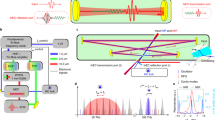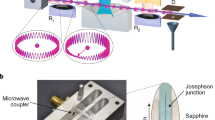Abstract
IN a comment on the electron spin resonance spectrometer designed especially for aqueous samples which has been described recently by Cook and Mallard1, Stoodley2 has calculated that the method of using a multimode microwave cavity tends to degrade the sensitivity rather than improve it. I would like to point out that support for Stoodley's result is provided by a spectrum recorded by Varian Associates on their aqueous sample spectrometer and published in some recent advertising material3. The signal-to-noise for this spectrum is some thirty times better than for that presented by Cook and Mallard. Further, although the sensitivity was said to be comparable with that obtained by Commoner et al.4, in fact these workers claim a figure of 2.5 to 5 × 10−7 molar of Mn++ while that of Cook and Mallard is 3 × 10−6 molar. The sensitivity of the Varian spectrometer expressed in these terms is 1 × 10−7. molar. The difference in sensitivity between that achieved by Cook and Mallard and by Varian can be attributed to three causes. First, sensitivity is proportional to the square root of the microwave power and, while Varian quote 180 mW, Cook and Mallard appear to be using a 723 A/B klystron which gives 20 mW. Hence the sensitivity drops by a factor of three. Secondly according to Stoodley, the cavity design should give a sensitivity which is 4.4 times worse than optimum. The remaining factor of 2.2 is due to deficiencies in the preamplifier used by Cook and Mallard.
This is a preview of subscription content, access via your institution
Access options
Subscribe to this journal
Receive 51 print issues and online access
$199.00 per year
only $3.90 per issue
Buy this article
- Purchase on Springer Link
- Instant access to full article PDF
Prices may be subject to local taxes which are calculated during checkout
Similar content being viewed by others
References
Cook, P., and Mallard, J. R., Nature, 198, 145 (1963).
Stoodley, L. G., Nature, 198, 1077 (1963).
Varian Associates, V-4502 E.P.R. Spectrometer Systems, No. INS 1454A.
Hollocher, T. C., and Commoner, B., Proc. U.S. Nat. Acad. Sci., 47, 1355 (1961).
Wallman, H. B., MacNee, A. B., and Gaddesden, C. P., Proc. Inst. Rad. Eng., 6, 700 (1948).
Ingram, D. J. E., Free Radicals as Studied by Electrons Spin Resonance, 83 (Butterworths, 1958).
Moxon, L. A., Recent Advances in Radio Receivers, 25 (Camb, Univ. Press, 1949).
Author information
Authors and Affiliations
Rights and permissions
About this article
Cite this article
WILMSHURST, T. Use of Long Cavities for Aqueous Samples in an Electron Spin Resonance Spectrometer. Nature 199, 477–478 (1963). https://doi.org/10.1038/199477b0
Issue Date:
DOI: https://doi.org/10.1038/199477b0
This article is cited by
-
Use of slow-wave spirals in recording ESR spectra
Theoretical and Experimental Chemistry (1966)
-
Use of Long Cavities for Aqueous Biological Tissue Samples in an Electron Spin Resonance Spectrometer
Nature (1964)
Comments
By submitting a comment you agree to abide by our Terms and Community Guidelines. If you find something abusive or that does not comply with our terms or guidelines please flag it as inappropriate.



